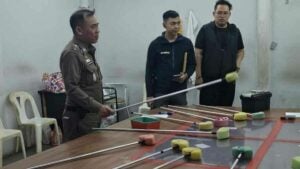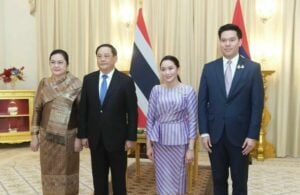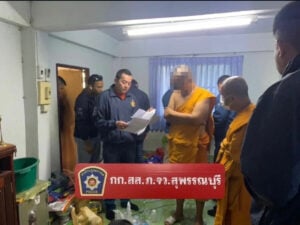Thailand beats leprosy with royal backing and medical strides

Leprosy, an ailment that has afflicted humankind for millennia, encountered a formidable challenge in Thailand through the initiatives of the monarchy and concerted public health endeavours. This article offers an in-depth analysis of Thailand’s transformation of its campaign against leprosy into a narrative of victory. It delineates the comprehensive strategy employed for the management of leprosy within the nation, highlighting significant achievements and the pivotal support rendered by royal patronage.
The crusade against leprosy in Thailand exemplifies the efficacy of collective commitment and determination. Executed under the auspices of the Raj Pracha Samasai Foundation with royal endorsement, Thailand embarked on an ambitious mission to not merely control but eradicate leprosy as a significant public health issue. This narrative is characterized by systematic interventions and steadfast support from His Majesty King Bumiphol Adulyadej, whose contributions were vital for achieving sustainable eradication.
An exploration into Thailand’s historical confrontation with leprosy reveals a complex strategy that rendered what seemed insurmountable feasible. From founding specialized entities such as the Raj Pracha Samasai Institute to broadening volunteer initiatives beyond specific groups affected by leprosy, Thailand’s path is enlightening. Prepare to examine how a nation unified to reverse the course against leprosy, establishing a global standard in public health excellence.
Early record of leprosy in Thailand
Leprosy, a disease as old as human history, has left its mark on Thailand. Understanding its early presence and the cultural response to it sheds light on Thailand’s comprehensive battle against this affliction.
Ancient Thai beliefs and practices
Leprosy in Thailand was not just a medical condition; it was steeped in cultural beliefs and social stigma. In ancient times, Thais often associated leprosy with spiritual and moral failings. Community isolation was a common practice, not just for health reasons but as a form of social purification. Traditional Thai medicine practitioners used a mix of herbal remedies and spiritual rituals in an attempt to cure or contain leprosy, reflecting a deep intertwining of health and spirituality.
Documentation from centuries ago illustrates the high regard for cleanliness and balance, believed to ward off diseases like leprosy. Despite these efforts, leprosy persisted, largely due to a lack of understanding of its transmission and effective treatment.
Evidence from archaeological findings
Archaeological digs in Thailand have unearthed evidence of leprosy dating back centuries. Skeletons with deformities characteristic of leprosy suggest it was a known entity as early as the 6th century. These findings not only confirm the presence of leprosy in ancient Thailand but also hint at its social impact.
Certain burial sites, distinct and separate from mainstream cemeteries, suggest that individuals with leprosy were often buried away from the community, underscoring the stigma they faced. These sites offer invaluable insights into how ancient societies managed diseases and the afflicted.
The discovery of medicinal containers near these sites, believed to contain remedies for skin diseases like leprosy, highlights the attempts made to manage the condition. These efforts, albeit early by today’s standards, laid the groundwork for Thailand’s journey towards effective leprosy control.
Spread of leprosy in Thailand

Impact of foreign trade
The history of leprosy in Thailand intertwines deeply with the nation’s interaction with foreign traders. As these traders navigated the seas to open new routes for commerce, they inadvertently became carriers of this affliction. Leprosy, a disease long affecting humanity, found fertile ground in Thailand due to these burgeoning trade links. Historical records suggest that the increase in foreign trade during certain periods correlated with a rise in leprosy cases. This connection highlights the global nature of health epidemics, transcending borders with ease. Your understanding of leprosy’s spread in Thailand wouldn’t be complete without acknowledging the role of international commerce in facilitating this unfortunate exchange.
Leprosy control measures in ancient Thailand
Long before modern medicine provided answers, Thailand had its strategies to combat leprosy. Ancient Thai society, recognizing the severity of the disease, implemented measures that can be seen as precursors to contemporary public health policies. Isolation was a common strategy; individuals displaying symptoms of leprosy were often segregated from the rest of the community, a practice rooted in reducing transmission. Moreover, traditional Thai herbal medicine plays a significant role in managing leprosy symptoms. These remedies, while not cures, were crucial in improving the quality of life for those affected. Temples and herbalists offered solace and treatment, utilizing the biodiversity of Thailand’s flora to offer relief. This aspect of leprosy control underscores Thailand’s rich history of integrating natural resources into health care practices.
The dissemination of leprosy in Thailand uncovers a complex history, intertwined with the effects of international trade and historical containment strategies. This narrative not only demonstrates the resilience of the Thai population but also highlights the intricate challenges faced in addressing a pandemic. Through various methods, including isolation tactics and the application of traditional herbal remedies, Thailand has exhibited exceptional flexibility in managing the adversities presented by leprosy.
Stigma and discrimination
In analyzing the historical backdrop of leprosy in Thailand, it is crucial to recognize the social ramifications of the disease. The persistent stigma and discrimination linked to leprosy have fostered a widespread sense of isolation among affected individuals.
Cultural perceptions of leprosy
In Thailand, cultural myths surrounding leprosy have significantly fuelled stigma. Leprosy in Thailand is often seen as incurable and hereditary, an incorrect but powerful narrative from the past. The notion is deep-rooted, based on a lack of awareness and understanding. This misconception has isolated sufferers, not only within their communities but also within their families. The history of leprosy in Thailand is thus not just a medical tale, but a social narrative filled with misplaced fears and misconceptions.
Impact on leprosy-affected individuals
The repercussions for individuals diagnosed with leprosy extend beyond physical symptoms. Stigma effectively compounds their suffering. They face discrimination in various spheres of life, including employment and social interactions. Opportunities shrink, not because of their physical limitations but due to societal labels. Workshops and vocational training centres offer some respite, enabling affected individuals to learn new skills. However, these efforts only partially address the broader discrimination issue.
In many cases, the stigma is more debilitating than the disease itself. Its profound psychological impact can deter people from seeking timely medical help, propelling a vicious cycle of disease and discrimination. Breaking this cycle requires a dual approach: medical intervention to manage leprosy and educational campaigns to dismantle myths, promoting a more inclusive society.
Treatment and care

Evolution of leprosy treatment in Thailand
The evolution of leprosy management in Thailand is marked by substantial progress and innovation in treatment approaches. Initially, the national strategy for addressing leprosy was predominantly characterized by segregation practices and minimal medical interventions. In the early 20th century, therapeutic methods were elementary and largely unsuccessful. However, a significant breakthrough occurred with the advent of dapsone in the 1940s, a drug that transformed leprosy management by providing the first effective means to combat the disease. Despite its initial success, resistance to dapsone eventually emerged, highlighting the critical need for advanced therapeutic options.
In response to this imperative, the implementation of Multi-Drug Therapy (MDT) in the 1980s constituted a major milestone in leprosy treatment globally, with profound implications for Thailand. This regimen, comprising several drugs, not only enabled successful patient outcomes but also significantly diminished transmission rates. This strategy exemplifies Thailand’s dedication to integrating global best practices into its domestic leprosy management framework. Presently, Thailand offers MDT free of charge as part of its comprehensive national leprosy control initiative, demonstrating an evolution from basic and ineffective treatments to sophisticated and all-encompassing care protocols.
Role of healthcare professionals in leprosy management
Healthcare professionals hold a critical position in the battle against leprosy within Thailand. Their duties surpass merely providing clinical treatment for the disease. They are at the vanguard of public health endeavours designed to enlighten communities regarding leprosy, thereby dispelling myths and eliminating the stigma associated with this condition. This includes executing health promotion activities, vaccinations, and screenings to curb the proliferation of the disease.
A fundamental aspect of their responsibility entails guaranteeing prompt diagnosis and treatment to avert disabilities. Healthcare practitioners, possessing specialized training, adeptly address the complexities involved in early-stage leprosy detection. Their proficiency is indispensable, particularly in rural locales where healthcare service accessibility may be constrained. Moreover, they offer psychological support to both patients and their families, endorsing a comprehensive care approach.
The unwavering commitment exhibited by healthcare professionals in Thailand has played a significant role in refining leprosy management practices. Through their persistent endeavours, Thailand has achieved notable strides in diminishing the impact of leprosy, evolving from a historically feared malady into a condition that is now treatable and manageable with effectiveness.
Current situation and future outlook
In the examination of the historical context of leprosy in Thailand, it is imperative to recognize the current status. The nation has made significant progress in addressing leprosy, evolving from basic treatment methodologies to the implementation of advanced multi-drug therapy (MDT). This advancement represents a pivotal achievement in Thailand’s history of managing leprosy. Presently, Thailand implements a comprehensive national leprosy control program that provides MDT at no cost, reflecting its dedication to eliminating this affliction.
The incidence rate of leprosy in Thailand has markedly diminished as a result of these focused efforts. Untimely detection and continuous treatment have been instrumental in curtailing transmission rates. Educational initiatives are crucial, ensuring that communities are informed about symptoms and the urgency of seeking medical consultation immediately. Medical professionals play an essential role in this endeavour, armed with the requisite knowledge and resources to diagnose and treat leprosy efficiently.
In a remarkable leap forward, AI prosthetics are enhancing lives through personalized and adaptive technology. These cutting-edge devices offer individuals with amputations unparalleled functionality, closely mimicking natural limb movements. By learning and adjusting to the user’s habits and environment, AI prosthetics represent a significant advancement in biomedical engineering, promising a future where limitations are increasingly surmounted by innovation.

































